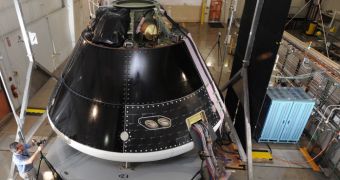Yesterday, May 24, the American space agency announced that it plans to conduct deep space exploration using the Multi-Purpose Crew Vehicle (MPCV), a spacecraft developed by Lockheed Martin, and based on Project Constellation's Orion Crew Exploration Vehicle. The corporation now salutes the official decision.
When US President Barack Obama decided to terminate Project Constellation, the Bush-era space program meant to take people back to the Moon by 2020, the NASA contract under which Lockheed was developing Orion could not be terminated.
As such, the space agency had to wait for funds to run out, at the end of this year. But this turned out to be a good thing in the end, since the work Lockheed engineers put forth in this interval is what made the selection of the Orion platform as the MPCV possible.
Also worthy of mention here is the fact that the new space vehicle – now destined to visit near-Earth objects (NEO) by 2025 and Mars by the mid-2030s – can be built within currently proposed budgets.
Officials at the Bethesda, Maryland-based corporation now salute the NASA decision, saying that the space agency took a sound approach to making the presidential directives for space exploration a reality. The move NASA announced will influence American plans in space for decades.
With the selection of the technologically-advanced Orion platform as the basis for the new flagship space vehicle, NASA ensures the United States' strong global leadership position in space.
“The Orion/MPCV spacecraft was designed from program inception to serve as the nation’s next generation spacecraft to take humans far beyond low Earth orbit to multiple destinations throughout our solar system,” a Lockheed press release reads.
“With a proven launch abort system, cutting edge technology advancement and state-of-the-art fabrication and assembly facilities, the NASA-Lockheed Martin Orion team is moving our nation’s strong, viable space industry expeditiously into the future,” the document states.
“New systems and technology continue to be developed and tested every week, such as the STS-134 on-orbit test of an innovative navigation sensor that will set the new standard for safer, more accurate docking operations for all future spacecraft,” the press release adds.
Initial crewed operations for the Orion/MPCV spacecraft are scheduled to be achieved by 2016, as instructed by Congress in the NASA Authorization Act of 2010. In the mean time, the space agency will continue funding private space companies developing proprietary space vehicles in the US.
“We are proud to be part of the NASA-industry team building a safe, reliable Multi-Purpose Crew Vehicle that will support America’s future human space flight endeavors on a series of increasingly challenging human exploration missions to destinations throughout our solar system on the path to Mars,” Lockheed experts conclude.

 14 DAY TRIAL //
14 DAY TRIAL //